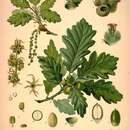Biology
provided by Arkive
The seedlings of sessile oak are more tolerant of shade than those of pedunculate oak, which enables the species to regenerate in woodlands (5). This deciduous tree is long-lived, typically reaching 1000 years of age (6).
Acorns were once widely used to feed pigs; they were also ground down to make a substitute for coffee and even a type of bread. A good crop of acorns was used to predict a good harvest, and a heavy fall of acorns was thought to signal an impending harsh winter (2). Sessile oaks do not yield as many acorns as pedunculate oaks, and the timber was less highly valued. Coppicing of these oaks was common in the north and west of Britain; this practice produces many thin poles of wood. The wood was burned in the iron-smelting industry and the bark was used in the leather tanning industry as a source of tannin (4).
Oak trees support a staggering variety of wildlife, and are habitats in their own right. The open canopy of sessile oak lets light through to the ground, which favours the growth of a diverse ground flora (7).
Conservation
provided by Arkive
Upland oak woodland is a priority habitat under the UK Biodiversity Action Plan (UK BAP). An action plan has been produced to guide the conservation of this habitat (8). Not only is this oak a beautiful, majestic species, it also supports communities of plants, animals and fungi that are unique, rare and internationally significant. Conserving this 'king of trees' is therefore of utmost importance.
Description
provided by Arkive
Oak trees have a special place in the English psyche, and are well-loved symbols of strength (4). The crown of this magnificent native tree is domed, with branches that radiate outwards and are straighter than those of Britain's other native oak, pedunculate or English oak (Quercus robur). Another distinction between these two oaks is that the crown of sessile oak appears more open when in leaf, as the leaves are evenly spread rather than in clusters as they are in pedunculate oak (3). The bark is greyish in colour and has mainly vertical fine fissures and ridges (3). The dark green leaves are smooth on the upper surface but pale green and hairy below. They usually have five lobes on each side, which gives a typical 'wavy-edged' outline (2). The sessile oak is so called because the acorns are not supported on stalks ('peduncles') as they are in the pedunculate oak (4).
Habitat
provided by Arkive
Occurs mainly in semi-natural forests (4) on shallow, well-draining and acidic soils (5). This tree is the dominant species in upland oak woodlands (5). In scrub, plantations and hedgerows it is typically replaced by the pedunculate oak (4).
Range
provided by Arkive
The sessile oak tends to be found mainly in west and northern Britain (3). It was not favoured by foresters in the 18th and 19th century; its distribution today therefore tends to represent a relict of its original 'wildwood' range (5). It is found in most of western Europe and Asia Minor (6).
Status
provided by Arkive
Not threatened (3).
Threats
provided by Arkive
Upland oak woodlands have declined by 30-40% over the last 60 years as a result of re-planting with conifers, conversion to grazing land, overgrazing by sheep and deer, and unsuitable management (8). The decline in the ancient technique of coppicing has resulted in oak woodlands becoming more shaded; acorns do not germinate as well in these conditions. Many oak forests have a skewed age structure, as young trees are not able to regenerate (4). This may cause problems for many of the rare species that are dependent on ancient oaks. As the old trees die there will not be trees of a suitable age in the vicinity, so entire communities are at risk (9).

